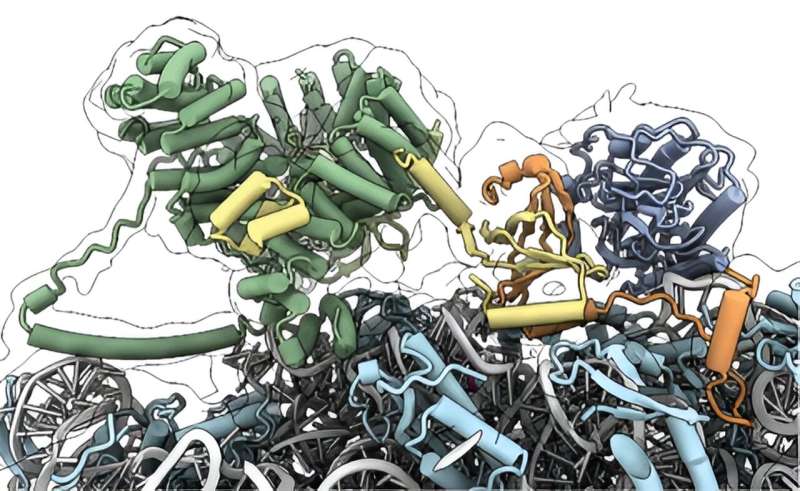This article has been reviewed according to Science X's editorial process and policies. Editors have highlighted the following attributes while ensuring the content's credibility:
fact-checked
peer-reviewed publication
trusted source
proofread
New research elucidates a master regulator of protein production

Proteins are among the most important molecular building blocks of life. They themselves are built from amino acids linked together based on the information in our genetic material. In this process, the genetic code is translated into a sequence of amino acids. However, this translation is only the first step. Often, special enzymes modify the new (nascent) proteins as they leave their cellular production site—the ribosome. Only after this can the proteins fulfill their diverse biological functions.
It has not been well understood how these enzymes work together to modify nascent proteins at the ribosome or how their activity is regulated and coordinated. Now an international team of researchers from Caltech, the University of Konstanz, and ETH Zurich has unraveled the complex molecular mechanism for two consecutive protein modifications that affect about 40% of all proteins in mammals. It turns out the star of the show, something of a molecular control hub, is a relatively small chaperone protein complex called NAC (nascent polypeptide-associated complex).
Without NAC, all sorts of stress responses are triggered, causing proteins to get misfolded or sent to the wrong locations in the body.
"The essential chaperone NAC has been involved or implicated in a myriad of processes. It has been difficult to understand why a single small protein complex that looks very simple would impact all of these different processes," says Shu-ou Shan, the Altair Professor of Chemistry at Caltech, executive officer for biochemistry and molecular biophysics, and corresponding author of a new paper describing the work.
"But now we're starting to see the full picture of NAC as a high-order master regulator of protein production in the cell. It has become clear that NAC's job is to recruit diverse biogenesis factors to the ribosome and pair them with the appropriate nascent proteins that are being synthesized."
The findings are published in the journal Nature.
Essential for normal cell function
In the new paper, the researchers focus on two modifications that NAC orchestrates—the removal of the first amino acid, methionine, from the growing protein, followed by the attachment of what is known as an acetyl group to the remaining end.
Both processes take place at the ribosomal tunnel exit, i.e., at the location where the proteins leave the ribosome as a growing chain of amino acids during synthesis. These modifications are essential for the majority of our proteins, as they influence multiple protein properties, such as their three-dimensional folding, lifespan, or interaction with other proteins, and thus the proper function of the proteins.
"A dysregulation of the processes involved in protein modification can have extremely negative consequences for the organism. It is associated with developmental disorders or diseases such as cancer and Parkinson's, for example," explains Elke Deuerling, professor of molecular microbiology at the University of Konstanz in Germany, and an author of the new paper.
The mechanism in detail
The time slot for the cleavage of methionine and the subsequent acetylation to occur smoothly is quite short. During this time, several enzymes must be brought to the right place and be regulated: MetAP1, which causes the cleavage of methionine, and NatA for the subsequent acetylation.
However, NatA is normally bound by an inhibitory protein, HYPK, which suppresses its function. By combining biochemical, structural, and in vivo experiments, the Caltech researchers and their collaborators have now succeeded in shedding light on how this complex process is controlled and how the macromolecules involved interact.
NAC is located at the exit of the ribosomal tunnel, where newly synthesized proteins emerge. From there, it recruits both MetAP1 and NatA and positions them with their biochemically active regions at the appropriate locations near the tunnel exit to access the nascent protein.
"In addition, NAC induces NatA to lose its inhibitory contact with HYPK. This ensures that NatA's function is only activated at the ribosome, where it can then mediate the desired acetylation," Shan says.
Shan's lab developed the tools that uncovered these essential roles of NAC in NatA function, providing the basis to further solve the structure of NAC bound to a ribosome with NatA and HYPK.
"Making synchronized ribosomes with a defined nascent chain length and composition and to have that in biophysical quantities is hard," Shan says. "My group has worked for many years to develop tools that allowed us to incorporate fluorescent dyes specifically into a nascent protein on the ribosome. That is how we detected interaction and recruitment of these enzymes."
Previous studies revealed that NAC also recruits other factors to the ribosomal tunnel besides the enzymes MetAP1 and NatA.
"We assume NAC has the function of an even more elaborate molecular control hub," says Martin Gamerdinger, co-author of the paper also from the University of Konstanz. "It ensures that the nascent proteins have access to different components of the cell's biochemical toolkit as they leave the ribosome, depending on the requirements."
The current study shows how NAC fulfills this important function in the specific case of methionine cleavage followed by an acetylation. It provides scientists with a clearer understanding of the way dysregulations of the components involved in the modification of proteins can lead to the development of disease. In the long term, this could function as a basis for the development of new therapeutic approaches in medicine.
Additional Caltech authors on the paper, "NAC guides a ribosomal multienzyme complex for nascent protein processing," are Alfred M. Lentzsch and Sowmya Chandrasekar. Denis Yudin, Alain Scaiola, Nenad Ban are co-authors from ETH Zurich.
More information: Alfred M. Lentzsch et al, NAC guides a ribosomal multienzyme complex for nascent protein processing, Nature (2024). DOI: 10.1038/s41586-024-07846-7
Journal information: Nature
Provided by California Institute of Technology



















